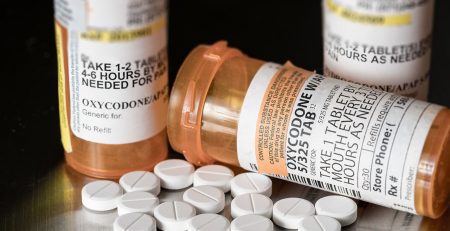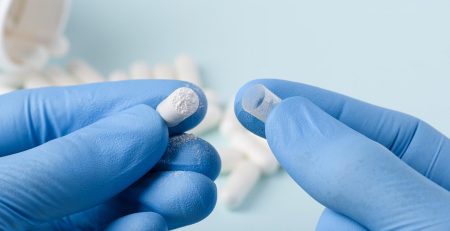Also known as Exalgo or hydromorphone, Dilaudid is a prescription opioid pain medication used to treat moderate to severe pain. As part of the opioid drug class and a derivative of morphine, hydromorphone is mainly administered in hospitals. When used as prescribed, the potential for overdose is low. However, when taken recreationally or misused – especially when combined with alcohol or other substances – the results can be dangerous and sometimes fatal. Considering the ongoing opioid crisis, our luxury treatment center in Palm Beach wants to spread awareness by sharing the dangers of mixing Dilaudid and alcohol.
How Does Dilaudid Work?
Formally known as hydromorphone hydrochloride, Dilaudid is a prescription opioid that’s commonly administered in a hospital setting to patients with severe pain, either as a shot or as a pill. Due to its potency and potential for abuse and addiction, it’s normally prescribed on an as-needed basis. A more soluble solution that’s derived from the commonly-prescribed morphine, Dilaudid works by binding to mu-Opioid receptors in the central nervous system to block pain signaling.
In addition to blocking pain, Dilaudid also manipulates dopamine and serotonin levels, acting as a depressant to reduce agitation from pain, produce sedation, and help the individual relax. Typical side effects of hydromorphone (Dilaudid) include:
- Constipation
- Dizziness
- Drowsiness
- Dry mouth
- Flushing
- Lightheadedness
- Nausea
- Sweating
- Vomiting
The severity and frequency of these side effects usually subside after a while of taking Dilaudid as prescribed. Unfortunately, hydromorphone-containing medications are often abused because of the euphoric high they cause when taken in high doses. Recreational users who take higher doses of Dilaudid than prescribed or take the drug without a prescription may experience side effects like:
- Euphoria
- Feelings of well-being
- Impaired judgment
- Numbing to physical and emotional pain
- Reduced anxiety
- Relaxation
- Sedation
When taken in higher doses than prescribed, administered differently than directed (snorting or intravenous use), or when mixed with alcohol and other drugs, a Dilaudid high occurs more intensely. This also means it’s more dangerous. With continued use of opioids like hydromorphone, users develop tolerance and require higher doses to experience the same high.
This type of drug-taking behavior tends to give way to physical dependence, which is marked by withdrawals. Withdrawal symptoms tend to be intense enough to make quitting difficult and otherwise contribute to long-term use. Medically opiate detox is the best form of care for individuals who want to take the first step toward getting sober. Our Palm Beach rehab offers various types of luxury detox programs that prioritize health, safety, recovery, and comfort on an individual level to ensure all clients receive care that meets their standards.
Side Effects of Mixing Dilaudid and Alcohol
Doctors are careful to assess and divulge any hydromorphone interactions with clients before prescribing the medication to prevent any dangerous outcomes. Yet, a number of people who take prescription drugs consume alcohol with them, despite their doctors’ warnings. This is why most, if not all, doctors inquire about their patients’ alcohol use prior to prescribing any medications, and for doctors who don’t, they should.
Even so, not all patients are fully forthcoming about their drinking habits. This could be because they believe they don’t drink “enough” for it to be a problem when taking medication or because they’re in denial about their drinking. Even when explicitly stated, either by healthcare professionals or warnings on pill bottles, these advisories often fall on deaf ears.
Overall, most prescription medications are not meant to be mixed with alcohol, including hydromorphone-containing medications like Dilaudid. Dilaudid and alcohol should never be combined because both substances work similarly to depress the central nervous system. When taken together, these depressing effects can be heightened and lead to a dangerous and even life-threatening outcome.
Possible side effects of alcohol and Dilaudid include:
- Confusion
- Euphoria
- Impaired judgment
- Increased risk for injury and accidents
- Interference with Dilaudid’s pain-relieving effects
- Overdose
- Respiratory depression
- Sedation
- Death
Dilaudid is associated with a high risk of respiratory depression, which is the deadliest of opioid overdose symptoms. When comparing standard doses of other opioids, Dilaudid is several times stronger than most prescription painkillers, including hydrocodone and oxycodone. As a result, the risk of abuse is even higher in relation to this medication.
Using hydromorphone and alcohol together considerably increases the risk of respiratory depression, mainly because of “dose dumping.” Dose dumping is when a large amount of a drug, specifically one intended to be administered via a controlled-release formulation such as an extended-release (ER) formula, is quickly released. Mainly seen with Palladone and alcohol interaction, alcohol is discovered to interfere with the mechanism that regulates the release of hydromorphone ER.
As a result, rather than release gradually into the body, hydromorphone is dumped into the user’s system all at once, increasing the risk of overdose and death. The sedation and impaired judgment that is also common in alcohol and opioid interactions can also increase a person’s risk of injury and death.
Polysubstance abuse, or the use of multiple substances at a time, can also increase a person’s risk of developing an addiction. Using opioids and alcohol for long periods often leads to tolerance, physical dependence, and substance use disorder, which is marked by an inability to control use despite the repercussions. At this point, it’s advised that the addicted individual receive drug or alcohol addiction treatment as soon as possible for the highest chance of recovering.
Alcohol and Dilaudid Addiction Treatment
Opioids are among the most commonly abused substances in the world and one of the most addictive. Therefore, to reduce the risk of relapse and other complications, it’s advised that individuals with opioid addictions seek out medical care for recovery. If you or someone you love is in this position, our luxury drug and alcohol rehab in South Florida can help.
We offer alcohol and opioid addiction treatment, among a variety of other luxury rehab programs to ensure our patients receive the care they need in an environment that mimics the comfort they’re accustomed to enjoying in their home lives.
For more information about our luxury addiction treatment in Palm Beach, call Seaside Palm Beach today at 561-677-9374 or send us your contact information, and we’ll reach out to you.
Related Reading:
How Long Does Dilaudid Stay In Your System?
What Is the Difference Between Dilaudid and Morphine?













